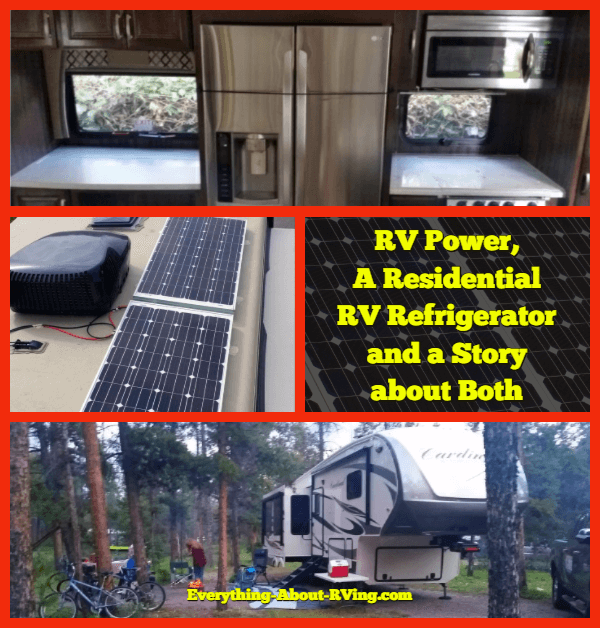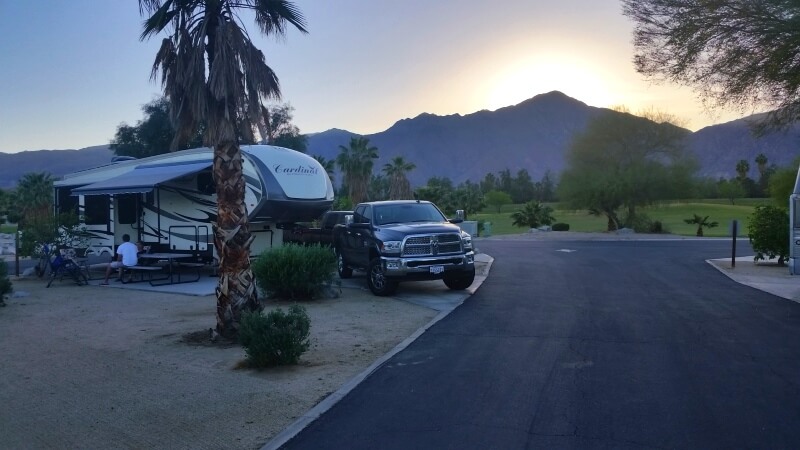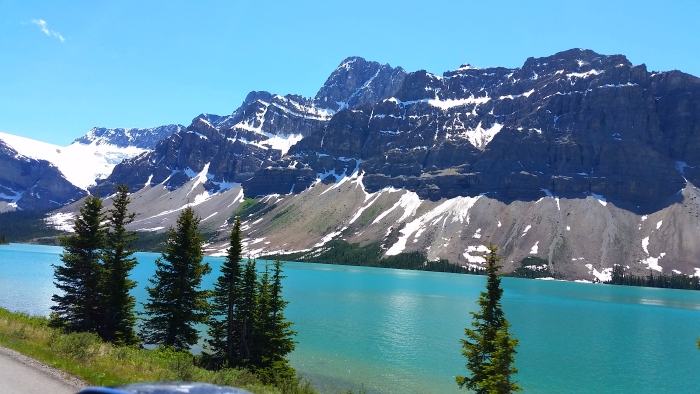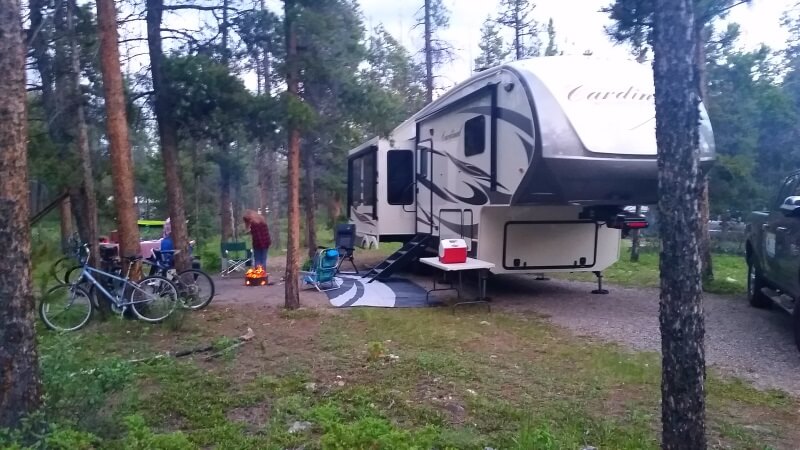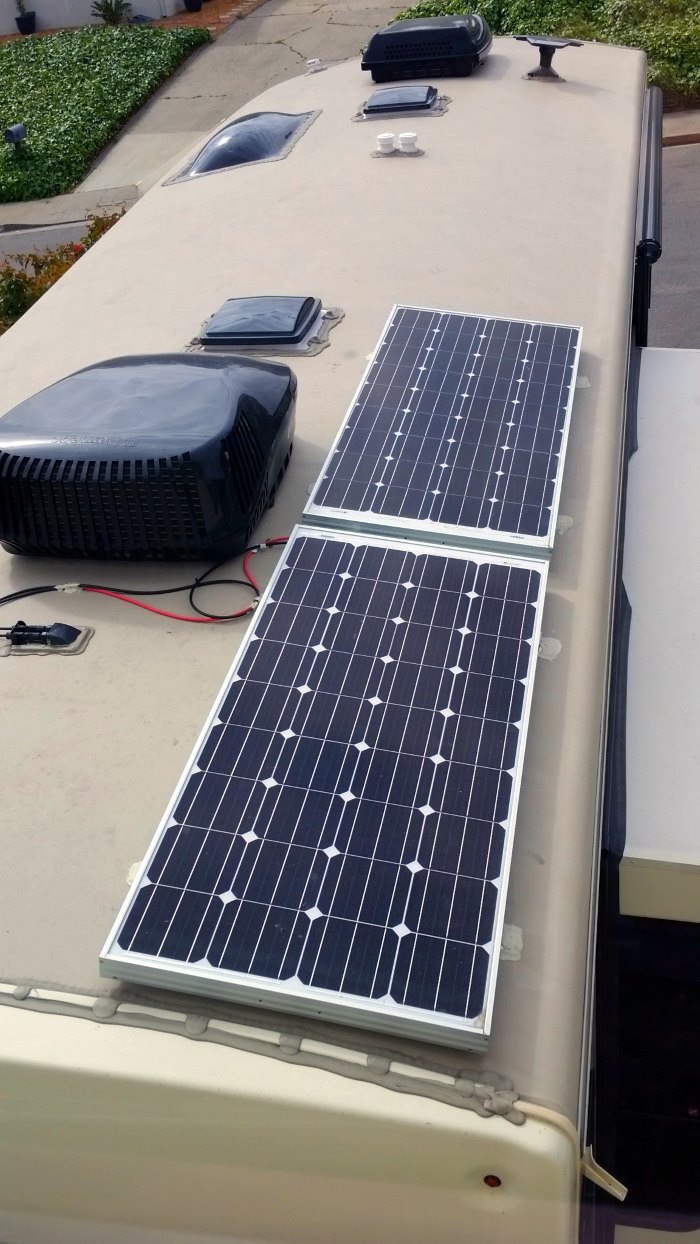- Home Page
- Favorite RV Accessories
- Rv Power
RV Power, A Residential RV Refrigerator and a Story about Both
Choosing the right power source is very important
By Russ Lovell
Chosen Equipment and Rig – Part One
Speaking from first-hand experience I can say that power in your RV, for both AC and DC devices and appliances, is all important, especially if you have a full size residential refrigerator in your rig that requires 110V – AC power, AND you want to camp off the grid, better known as “dry camping”.
We recently did a 6-week trip from June 15 through the end of July 2017. We traveled from San Luis Obispo, CA up to Jasper, Alberta Canada, then down through Icefield Highway along the Rockies. We made it back July 31st unscathed with our warm residential refrigerator in tow.
Many of the larger RV’s are offering 18 to 26 cu ft. 110V refrigerators. Yes, these are full size refrigerators in your RV, same as the one in your home. It is an option now and who knows, they may be standard someday if power technology keeps improving on the same track that it has.
These set ups require an inverter that turns your 12V DC current coming from your battery bank into 110V AC current, same as your house, so that it can power that big fridge.
Given the solar and inverter technology available today, as well as the LED lighting efficiency, many RV’ers are choosing this option. If you spend any time at all in your RV, it’s pretty cool to have all that fridge space, an ice-maker, temp control, power efficiency, and yes, even filtered water.
Not sure you can call this “camping”, but whatever it is we do quite a bit of it in State and National Parks, not just RV Parks. So, it’s cool to be in a remote location but still have all of the conveniences.
We had planned this Canada trip to break in the new 5ver, then after that spend about 6 months out of the year living in this monster as part-time/full timers. Needless to say, we needed a rig that we could live in and use for off-grid camping.
Given our situation, we had to figure out a way to bring our own power with us. Note: The single 12-volt deep cycle battery that they give you when you buy your RV is NOT enough power to keep a rig like this going, no matter what they say. You’re going to need more power.
I can’t say why the RV manufacturers don’t want to offer upgrades that include sufficient power needed for the environment they have produced. It baffles the mind, and assuming that profit is the motive somewhere in the product equation, why not offer it up? (Head Scratch).
Given that we only had after-market choices, we had to choose between the following: 1) A big on-board noisy and expensive power generator, 2) an inverter/charger/solar system, or 3) a combination of both. We chose the combo option with a small portable quiet generator used when the sun wasn’t shining.
Before the power decision, was the question of which rig to buy. We chose a 5th wheel; a 2017 Cardinal 3250. 35′ 3″ nose to stern. We haul it with a Ram 2500 Turbo Diesel which works well.
We chose the following power configuration: 2-160-watt solar panels, 4 AGM 6-volt deep cycle batteries, and a Go Power IC 2000 inverter/charger. This design was supposed to keep us in all the power we and our big fridge needed. It wasn’t over the top total off-grid, it was “appropriate for our needs”.
At this point in the story, I’m sure all you electronic engineers out there are starting to squirm. Good. I’d love to hear your thoughts and advice. I think many more folks are going to have the same kinds of power decisions to make and your input may be very helpful.
Now, with our power and equipment backstory out there, I’ll share our power woes which started at our first off-grid site in Jasper, Alberta Canada.
Tech Fail: Part Two
I don’t think I’ve ever experienced a more beautiful drive or scenery: Jasper and Banff National Parks in Alberta Canada are stunning. The experience absolutely blew my eyeballs away.
Having driven up from an RV Park in the Kamloops area on a cloudy and stormy day, we didn’t get much sun on our panels for the drive into Jasper. We had shore power at the RV Park, so I wasn’t too concerned. We set up camp in a dry site at Wabasso Campground. Not easy to maneuver in to that tricky spot, but we did it. All is well so far, until… morning number one, we woke to sound of a faint alarm consisting of 3 short beeps coming from the storage bay where the inverter/charger was located.
It turns out that this Go Power inverter smart enough to keep your batteries from discharging beyond a safe limit. It simply turns itself off. Of course, this means everything turns off, including your fridge
After reading up on how the inverter works, we were able to determine that the alarm was a good thing and we simply needed to charge the batteries. No sun, no problem, or so we thought. Should be fine with quick charge. We cranked up the generator and let that go a couple hours.
Between a bit of sun and the charge from our Honda 2000 generator, we thought we had enough juice to crank it all back up. The sun would soon be shining directly on our two solar panels and we’d be back in business.
Not so. We ran the batteries down below 11.5 volts. The generator wasn’t charging properly for some reason. We got about 20 minutes of 110-volt juice before the UVP alarm sounded and our power was out again. Uh oh.
We had another 4 days off the grid in Jasper planned. This clearly wasn’t going to work. Step one was to call someone who knew power. We called a local RV repair guy in Hinton, AB who knew solar power and serviced RV’s from a mobile truck, but he never answered my voice mails, emails, and general pleas for help, so that wasn’t going to be an option.
We then called the folks at DDRV in Westminster, California who we bought the rig from and who installed the system. After all, they installed it, so they should know what the issue was, right?
Doug, our service rep, was nice enough. His advice was to use a separate battery charger to get the batteries back to full before starting the inverter again. He figured we had run the batteries so low, we had no choice but to bring them to full charge. Well, that required a 4-hour round trip drive to from our campground in Jasper, to the town of Hinton for a battery charger. Aaargh!!
After the drive, the subsequent charging with a 20-amp battery charger, more intermittent sun, and a lot of frustration we tried again. After all, we used the correct charger settings for AGM batteries and now the voltage was up to 13.4. We got it all turned back on and what did we get? About 60 minutes of power. We went to bed that 3rd night knowing the frozen fish wasn’t so frozen anymore.
We transferred some critical foods to my brother’s trusty, but tiny propane RV fridge, but we couldn’t fit it all. We needed power real fast. We were in luck; a cancellation allowed us to move from Wabasso campground to Whistler’s campground on our last night. It was a site that had 30-amp shore power and lots of Elk. Phew, saved for now, (or so we thought).
Part 3 – The problem
By no means were we out of the woods yet. We were able to get the fridge back up and operating, the batteries took a full night charge, so off to Banff we went
The drive from Jasper to Banff is truly spectacular. The views are so breathtaking, you simply can’t believe what your eyes are taking in. That was a great day, until we arrived.
By the time we arrived and set up at the Lake Louise campground, just 4 hours later, the inverter was in alarm again and had turned itself off. The fridge wasn’t running, and we were without AC power yet again. But luckily we had shore power at Lake Louise, so good for now.
After all this expense; solar, powerful inverter, and battery upgrade, we couldn’t make it 4 hours without shore power? This was unacceptable. We were pissed off, and that’s putting it lightly. What was going on? With a full charge on the batteries, why wouldn’t it power the system? The damn thing came with one 12-volt battery, I upgraded to 4 deep cycle 6-volt AGM batteries. What the hell?
We got in touch with “Mike”, lead tech at Go Power, to try and trouble shoot. Great guy and very knowledgeable. He was accessible, great follow through, and very helpful over the next few days and many calls. By now I’ve read a lot about how the I/C 2000 worked; settings, alarms, and specs. Mike has walked me through a lot and I’m feeling much more in control and still happy I went with Go Power.
It turns out that we had multiple problems. First, the cables installed from the battery bank to the inverter were undersized. I read the metric info on the cables to Mike who said, “That’s not our cable. That’s something else and not to spec.” Two-gauge cables are called for in the Go Power specs, DDRV installed smaller gauge “welding cables”. They weren’t even from the GoPower wiring kit we purchased from DDRV. Yes, I’m extremely upset at this point
Second, the system requires a 300-amp breaker between the batteries and the inverter. Again, a 300 Amp breaker comes in the kit that I purchased, but DDRV installed a 200-amp fuse which had blown between Jasper and Banff. We bypassed the fuse at the block to confirm that the breaker was blown. The nearest place to get a fuse; Calgary, another 4.5-hour round trip drive. Wow, really?
At this point in our adventure we we’re beyond upset and simply in problem solving mode. There’s a point in any challenging situation where blame just isn’t a solution. We had to solve this and deal with the cause and justice later. So, we made the drive and picked up the $162 fuse and matching block required. Installed it, and proceeded with the process of charging, then testing, charging, and more testing.
We had more dry camping reservations coming up and spots of boondocking planned. From Banff, we had planned campsites at Redstreak, Kootenay National Park, Emery Campground at Hungry Horse reservoir near Glacier. All dry camps with more dry camping planned in Colorado and Utah. Ugh.
Dry camping wasn’t going to work. Our plans had to be changed, which isn’t easy in the middle of peak summer camping season. Everything is booked. We proceeded to move it all around and opt for power. We had no choice and it was absolutely no fun at all. Again, solutions, not blame.
We had to cancel 2 nights at Moraine Campground in Estes Park, CO and were able to squeeze in at Manor RV Park for the last 2 nights needed. We cancelled other National Park campgrounds in Bryce as well and opted for private parks with power.
This was all extremely maddening and disappointing, but you do what you have to do. Our expensive power system was now just about useless. It was getting us anywhere from 4 to 12 hours of off-grid AC power depending on the load and how deep the batteries where charged.
Conclusion: The wiring between the batteries and the inverter was just too small. The heat from those cables when inverting was too hot to touch. It didn’t appear to melt the insulation, but it was close. The fact is that the installation done by DDRV was not to code, and not to the Go Power specifications. They swapped the cable and fuse from the cable kit I purchased and used different parts.
Part 4: The solution
At this point in the story, readers should have two conclusions swirling around in their heads: First, do it yourself if you can. Owning an RV is expensive. It’s not an asset, it’s a money pit. If you can’t do the work yourself, then at least follow the next tip:
Check the work. Do your homework and know what you’re buying and who you’re buying it from. Not all dealers are bad, and I’m not even saying DDRV is bad. I’m saying that you should check their work. Get a second opinion on their advice or suggestions. Shop around and hold vendors accountable.
The last leg of our trip was Las Vegas to San Luis Obispo, CA. We left Vegas on the morning of July 31st and headed home. We stopped in Tehachapi for lunch and checked on the inverter. After all, we spent 3 nights plugged into 50A shore power. Four brand new fully charged AGM 6 volt deep cycle batteries would certainly power an ice cold refrigerator for a 7 hour drive.
The inverter was off after 4 hours of “off-grid” driving. The 300 amp fuse I bought in Calgary had blown. The draw was too much for even a 300-amp fuse. No doubt we were towing a fire hazard.
After we got home and settled, it was time to solve the problem. I called DDRV and scheduled an appointment for the following week. It’s a 4-hour drive from San Luis Obispo to Westminster, CA so we had to plan for accommodations. Another, ugh and big expense.
Doug was kind enough. Of course they would fix their mistake, and maybe more. We had them fix a bunch of warranty work while they were at it. Forest River gives you one year to find and fix all of their mistakes. After that, it’s on you. So, we asked DDRV to fix the shoddy work, lack of attention to detail: Molding that simply fell off, doors that didn’t close, blinds installed wrong, etc.
When I bought the rig, I knew I’d have issues; everyone does when they buy new. All of the advice from veteran RV’ers was buy 1 to 2 years old. Let someone else take the hit on depreciation and fight with dealers and manufacturers on repairs.
We knew this, but we also wanted what we wanted and this 5th wheel was it. It turns out that DDRV is the only Cardinal dealer in California, so we negotiated the price with Mike, a very nice sales rep with good follow through, then bought from DDRV.

We knew we wanted and needed more power given the residential fridge, so we went with the solar system and upgraded the batteries as recommended by Ryan in service. He said I should save money, and that I could always add more panels. So we started with the Go Power Elite Kit, according to DDRV we could always add more panels if need be. Made sense to me.
Well, I had no way of knowing how many I needed after our trip because they wired it wrong. It didn’t work at all. What I learned later, and what I wasn’t told, is that you can’t expand beyond 3 – 160W panels with the same 30-amp controller. It requires an upgrade to an 80-amp controller/regulator.
My beef with DDRV on this point is that not enough information was given. I’d have to replace the 30-amp controller with a $840 unit. It’s like installing the system twice to upgrade and go beyond 3 panels. I’m starting to get it now: Adding panels is a money maker for dealers.
I knew from all the post-install homework that I needed at least 3 panels, 6 being optimal given weather and location of campgrounds. I decided to have DDRV add one more panel while they were fixing the wiring issue. It was the max allowed on that controller. If I needed panels beyond 3, I’d do the work myself.
DDRV charged me $540 for the extra panel, plus 20% mark up. They agreed to discount one hour of labor by 50%, and refund me the cost of the fuse I bought in Calgary. “Is this the best you can do given all I went through?” Yes, was the answer. The 20% markup was $108, labor savings was $40. This tells you where their mindset was.
I explained that I was in the RV business and that I was going to tell this story; “Are you sure that this is how you want to leave it? Nothing else you want to do for me?” Confirmed. They had to make money to “keep the doors open”.
So, this is the story. It closes this chapter of extreme RV aggravation and education. It’s called experience and I’m simply sharing. It closes this chapter in my life, even if no one ever reads this or shares it. I got it out there.
You see, it wasn’t about the money for me, it was about principle. It was about integrity and how one conducts business. Is it first priority to give value or chase money? I probably could have yelled and gotten very upset. I could have gone to small claims and explained how they put my family’s life at risk. What would I get out of it besides a few bucks and a lot of aggravation?
In my opinion, the RV industry, in general, is first about chasing a buck. Many businesses seek first to provide value and service to customer. Wealth always follows if your priorities are straight.
What most RV’ers know, or should know is that the RV industry isn’t well regulated. The RVIA is the main association representing the RV industry. If your rig is RVIA certified, it means that the manufacturer passed the minimum standards of the RVIA in manufacturing, but what are those? Not easy to know, unless of course you’re a manufacturer. Go ahead and try.
Dealers are part of the industry, and yes, they’re out for profit. Will they try and get the most they can out of the buyer? Yes. Caveat emptor. Do your homework folks. There is nothing wrong with chasing profit but in this case, you better do your homework, or you will be skinned alive.
One of the main points of this article, besides making me feel better, is to educate. I wanted to explain what buyers of new RV’s are up against; the industry as a whole, the dealers, the quality of your new RV, and the people who earn their living from this industry. I think I’m fair in how I presented these facts and how this particular dealer responded with a solution, and we all know that every dealer is different.
I’ll leave you with this one last story to make my point: My company, RVPlusYou, attended the big RV Show in Pomona last year at the Fairplex. As a vendor, I was able to go in early, well before the show started and customers began to mill around and pine over the shiny new RV’s.
On the biggest day, a Saturday morning, I passed a large group of sales people preparing for the day. I won’t say the name of the dealer, it wasn’t DDRV but it was a So. Cal dealership. The sales manager was a woman leading the meeting and whipping up the sales team to “go sell”. She closed the rally with a song and dance: “I Wanna be Rich” played loudly for the team. “I want money, lots and lots of money…” were the lyrics. Need I say anything else? Enough said.
I hope this article helps those people shopping for RV’s. The industry had record sales last year and this year looks good as well. My hope is that this story will provide a glimpse into the industry and an idea of what you’re dealing with when you go to buy a new RV and choose the various features and options.
If you know an RV owner, or you know someone looking to buy, please pass this on and share. You might save them some heartache, you might help them with their power and refrigerator decision, or you just might help contribute to improving the RV industry. Hopefully they can steer themselves into a better direction.
About The Author
Russ Lovell is Co-Founder and Managing Partner of https://rvplusyou.com a peer to peer RV Rental website, with a focus on Delivered RV Rentals. RV owners share their RV for weekend getaways, festivals, weddings, tailgates, family reunions, and other events. Owners deliver and set up where the renter chooses.
RVPlusYou is different than other RV rental sites because they offer a safer way for RV owners to earn extra income: Renters don’t drive or tow the RV, so the problem of damage and depreciation are taken out of the mix.
Do you have any suggestions or comments on this topic? You can add them to this page by using the comments section located below.
